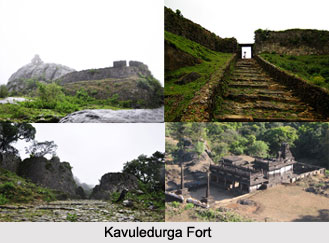 Kavuledurga Fort, also known as Bhuvanagiri Durga, is situated almost 18 km from Thirthahalli in the district of Shimoga, Karnataka state. The geographical coordinates are latitude 13.71879øN and longitude 75.12198øE. It was originally built during the 9th Century and was later renovated by Cheluvarangappa during the 14th century. The structure is mainly constructed with granite stones. It is situated on top of a hill at a height of 1,541 m.
Kavuledurga Fort, also known as Bhuvanagiri Durga, is situated almost 18 km from Thirthahalli in the district of Shimoga, Karnataka state. The geographical coordinates are latitude 13.71879øN and longitude 75.12198øE. It was originally built during the 9th Century and was later renovated by Cheluvarangappa during the 14th century. The structure is mainly constructed with granite stones. It is situated on top of a hill at a height of 1,541 m.
History of Kavuledurga Fort
It was a fortified defensive base of the Nayakas of Keladi, feudatories of the rulers of the Vijayanagar Empire. The Keladi Nayakas ruled independently after the decline of the Vijayanagar kings. The Keladi ruler Hiriya Venkatappa Nayaka strengthened the fortifications of Kavuledurga in the 16th century and renamed the structure as Bhuvanagiri Durga. He also built 7 ramparts on the top with regular gaps which were used for firing weapons. During his reign, a palace and Chaturvedimangalams or Agraharam (Brahmin quarter) with a Mahattina Matha were also built in the area.
Later the territory ands the fort was seized by Hyder Ali, the sultan of the Kingdom of Mysore in 1763. The name of the fort was again changed back to Kavuledurga.
Architecture of Kavuledurga Fort
The fortress included a treasury, stables for horses and elephants, water reservoirs and pools, a granary, Ghalige Battalu, a Sringeri Matha, warehouse for arms and ammunitions, a jail and other prominent buildings. Kavuledurga Fort comprises of three separate lines of walls that are built with massive blocks of granite.
Each of the fortifications comprises of a gate with guard rooms located on each side of the entrance. There are a number of temples located in between the fortifications. There are also remnants of an ornate basement of a large building and the site of a ruined palace. Recent excavations have revealed a series of interlinked rooms. There is also a wide verandah with pillars in the front. The palace consisted of a kitchen with 5 burner stone oven, a bath room with improved water supply system, a worship room, a large verandah which leads to a reservoir. On top of the hillock, there is another popular shrine known as Srikanthesvara temple. The temple includes a Garbhagriha. There are other temples as well, such as, a Kashi Vishwanatha Temple and a Sri Lakshmi Narayana Temple.
Presently the site of Kavuledurga Fort is open for all tourists and visitors and is being maintained by the Government of Karnataka.



















